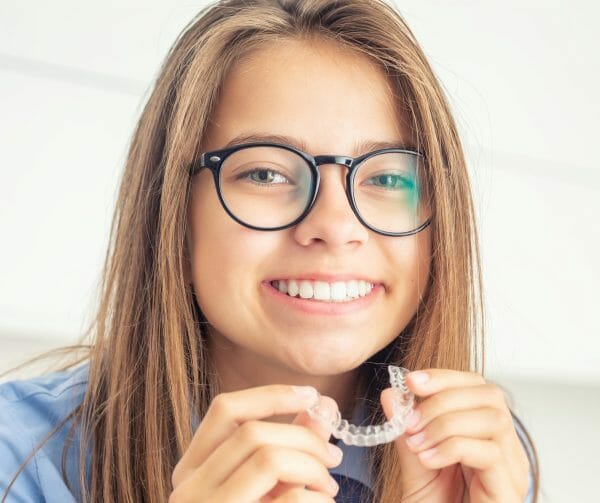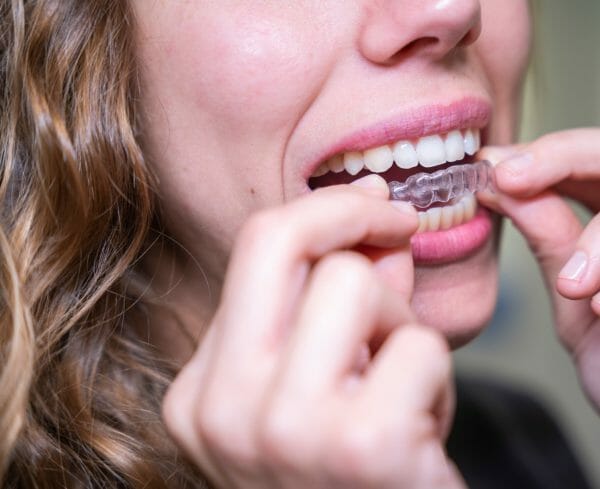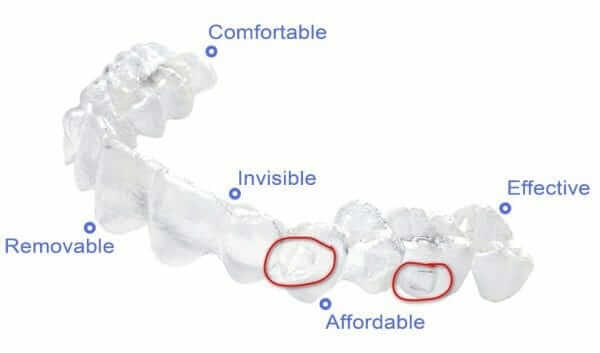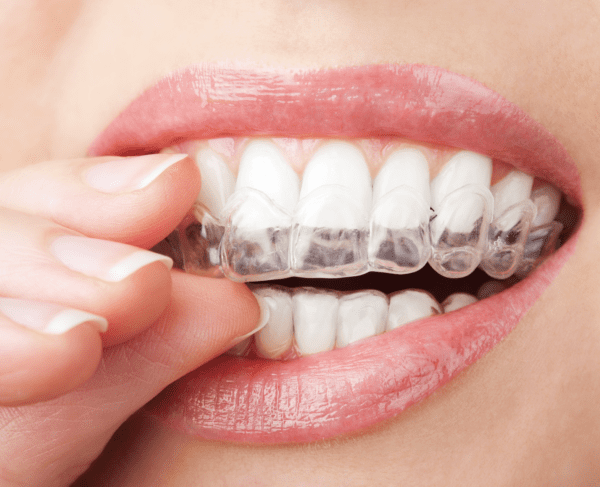What to Expect When Getting Your First Set of Invisalign Clear Aligners
What are Invisalign Aligners?
Invisalign aligners are customized trays used to shift teeth gently and accurately into their correct position over time. This can be a great choice for adults and older teens who are deemed good candidates for Invisalign, as the appearance of the trays is much less noticeable than traditional metal braces.
Is Invisalign Braces?
No, Invisalign is not braces, it is a braces alternative. Invisalign uses a set of clear plastic aligners that are removable to straighten the teeth. These aligners are also able to correct some problems with a person’s bite, such as an overbite.

What are the Benefits of Invisalign?
- Fewer office visits – Patients may need fewer visits to the office when being treatment with Invisalign clear aligners. Regular braces typically require office visits every 4 to 10 weeks to adjust, whereas Invisalign visits may be in the 8-to-12-week range. If a patient is deemed to be very compliant with treatment instructions, extended intervals between office visits may be possible.
- Less noticeable – Most adults and many teenagers will appreciate the almost invisible quality of Invisalign trays. This is a great choice for those concerned with the aesthetic appearance of traditional braces.
- No restrictions on diet – Invisalign trays are completely removable so there is no need to put limitations on diet. Chewy, hard, and sticky foods are allowed throughout treatment.
- Easier dental hygiene – Because Invisalign clear aligners can be removed, brushing and flossing is easier than with braces which require special brace flossers or other tools designed to keep the teeth clean.
- Fewer worries – Invisalign aligners do not have as many components that can be broken loose as braces. This reduces the chance of a situation (Ie. sporting activities enjoyed by teens) where a brace is knocked loose and makes for an extra visit to the orthodontist’s office for repair.
- More comfortable – Traditional braces can irritate the inside of the cheeks and lips and may take a bit of getting used to. Invisalign clear aligners are smoother, and the custom-fit nature eliminates most mouth irritation.
Who Qualifies for Invisalign?
In recent years, Invisalign technology has improved to include effectual treatment for a variety of orthodontic issues. However, it may not be the ideal solution for individuals that need major adjustments to their bite. Traditional orthodontic treatments would likely be a better choice for these cases.
However, Invisalign clear aligners can be effective (with some limitations) for several orthodontic problems, including:

How Does Invisalign Work?
The orthodontist begins by gathering information during the initial patient exam. Standard protocol is to take a series of facial and intraoral (inside the mouth) photos and two orthodontic x-rays. The orthodontist will then conduct a clinical exam of the patient’s teeth and supporting structures (gums and bone) to make sure it is safe to move the teeth. If the patient is deemed a good candidate for orthodontic treatment with aligners, a digital scan of the patient’s teeth is taken using an iTero intraoral scanner. This iTero scanner creates a replica digital image of the teeth, so the aligners fit precisely. The orthodontist then uses CAD/CAM software to move the teeth on a digital model to the desired final position. A series of trays are made from 3d printed models of the teeth according to the doctor directed prescription.
The first set of trays will begin the process of shifting teeth gradually into proper placement. Then, 1 to 2 weeks later, the next tray in the series will be used to continue that process. This progression through a series of trays every 1-2 weeks continues until the final outcome is achieved.
SmartForce Attachments (white colored material that is bonded to select teeth) allows Invisalign to be utilized on a broader range of patients that might not have been a good candidate for Invisalign clear aligners previously. These small tooth-colored attachments are adhered to a patient’s teeth at the beginning of treatment. The attachments serve as small handles to give the Invisalign aligner something to “grip” onto when making corrections.

Another Invisalign feature is called precision cuts, which allows the patient to hook up elastics to shift the bite into place while the aligners are straightening teeth.
Once treatment is complete, the attachments are polished off the teeth and retainers are made to hold the teeth in their final position.
Cleaning Invisalign Aligners
An important thing to remember about Invisalign and Invisalign teen aligners is that they must be cleaned properly. Although the aligners are replaced every 1 to 2 weeks, they still require good care. Rinsing aligners may make them appear a little cleaner, but unseen bacteria will remain. The following tips are recommended to keep the aligners fresh and clean:
- Rinse aligners with room temperature water.
- Brush aligners using a separate, soft-bristled toothbrush and a gentle, clear liquid soap or mouth wash.
- Rinse aligners thoroughly.
- Store aligners in a protective case when not in use.
- Soak aligners in an effervescent tablet solution to kill bacteria.
Invisalign Cleaning Crystals
Perhaps the best way to clean Invisalign clear aligners is with Invisalign crystals. Made by Invisalign, they clean without discoloring or scratching the trays.
To use the crystals, fill a container with room temperature water. Open one packet of the cleaning crystals and stir into water until completely dissolved. Place the trays into the solution, allowing them to soak for 15 minutes. Remove and then brush the aligners before rinsing.

What Difference Can Invisalign Clear Aligners Make?
Some patients will begin to see changes in as quickly as several weeks with Invisalign and Invisalign teen, although this is not as common. Usually, a notable difference can be seen at around the three-to-six-month mark.
If no marked improvement is noticed or the aligners do not seem to be fitting properly, a follow-up appointment should be scheduled promptly to make sure treatment is progressing effectively.
One of the most critical factors is that all instructions for wear are followed (at least 20-22 hours a day.) Failure to follow these guidelines will result in an extended treatment plan or a compromised result. Every time the trays are removed, the process is essentially paused. Only remove the aligners to eat, brush and floss.
View Burke & Redford Orthodontists Invisalign before and after photos of real patients. You or your teens smile transformation can be achieved through Invisalign treatment when in the right hands.
Give Us a Call During Business Hours at (951) 699-8011, Monday through Thursday, or schedule your complimentary orthodontic consultation to meet with Dr. Redford through our website anytime to discuss Invisalign clear aligners or braces options.